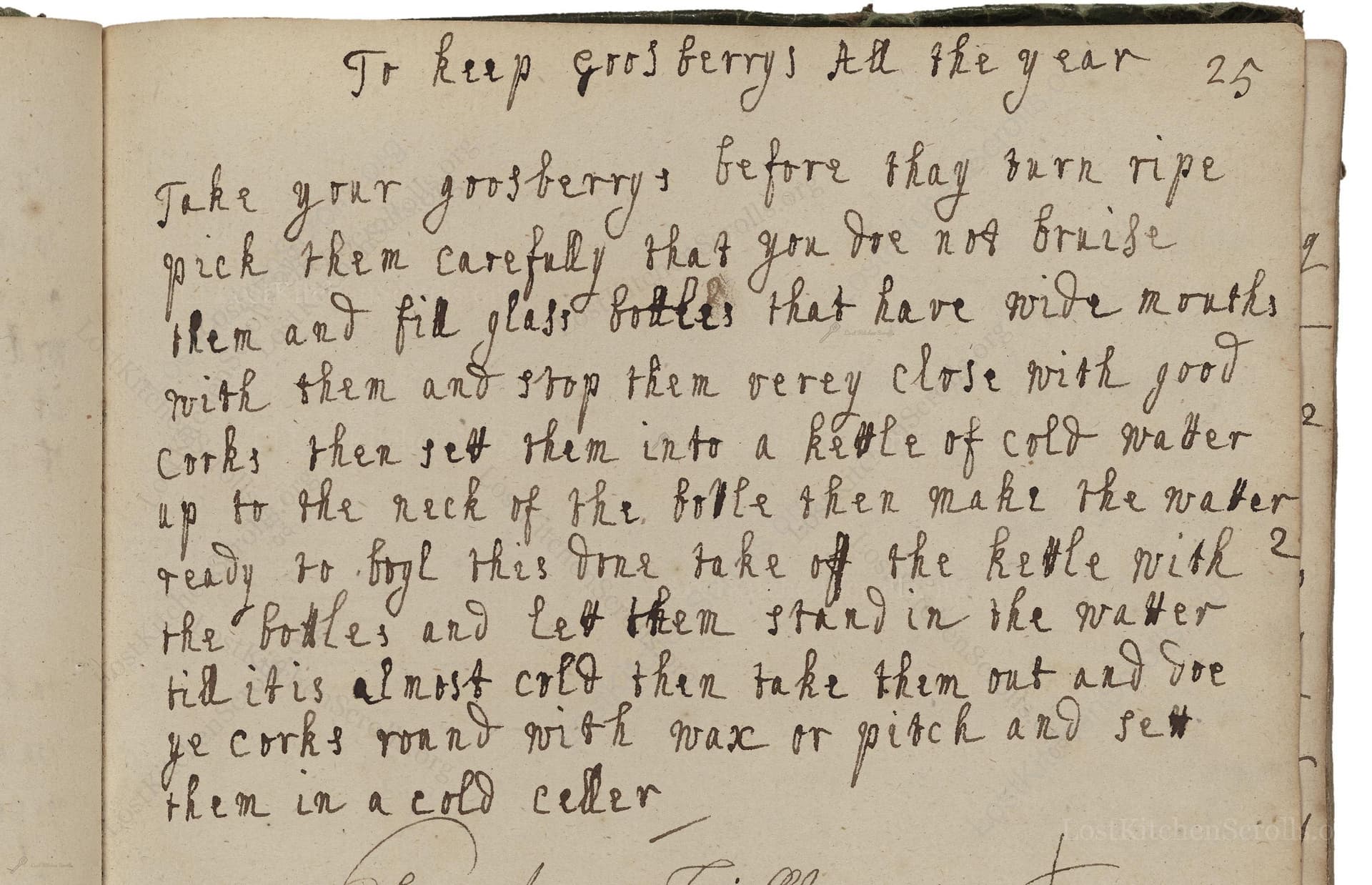To Keep Goosberrys All The Year
From the treasured pages of Cookery book of Jane Webb, compiled by several people
Written by Jane Webb

To Keep Goosberrys All The Year
"Take your goosberrys before they turn ripe pick them carefully that you doe not braise them and fill glass bottles that have wide mouths with them and stop them verey close with good corks then sett them into a kettle of cold water up to the neck of the bottle then make the water ready to boyl this done take of the kettle with the bottles and let them stand in the watter till it is almost cold then take them out and doe ye corks round with wax or pitch and sett them in a cold celler"
Note on the Original Text
The recipe is written in typical early 18th-century English, with variations in spelling (e.g., 'goosberrys', 'boyl', 'cellar') and informal measurements. It assumes a reader understands quantities by context and has knowledge of household preservation techniques. Instructions are given in a single, run-on paragraph, reflecting the oral tradition from which many such recipes descended. Standardization was rare; the focus was on technique and outcome rather than precise quantities or timing. 'Corks round with wax or pitch' refers to coating the corked seal with a waterproof layer, a common pre-canning practice to exclude air and spoilage agents.

Title
Cookery book of Jane Webb, compiled by several people (1738)
You can also click the book image above to peruse the original tome
Writer
Jane Webb
Era
1738
Publisher
Unknown
Background
A delightful glimpse into the culinary world of early 18th-century England, this manuscript offers a playful array of recipes and kitchen wisdom, reflecting the tastes and ingenuity of its era.
Kindly made available by
Folger Shakespeare Library
This recipe is drawn from an English household manuscript dating from approximately 1725 to 1750 and attributed to Jane Webb. In the early 18th century, home preservation was essential for ensuring fruit was available throughout the seasons, particularly through the winter months. Before refrigeration or modern canning, cooks relied on ingenious methods to keep fruits like gooseberries fresh. The technique here mirrors an early form of hot-water preservation, anticipating later developments in bottling and canning. At the time, cellars provided natural cool storage, and sealing with pitch or wax was a practical way to keep out air, mold, and pests. Householders would have used whatever glassware was available and tightly fitting corks were prized for keeping the contents fresh.

In Jane Webb’s kitchen, this recipe would require wide-mouthed glass bottles or jars (typically recycled bottles), stout corks, a deep kettle for boiling, and access to wax or pitch for sealing. A cold cellar or larder would serve as the storage location. Modern cooks can substitute glass canning jars and metal lids, a large stockpot or canner for processing, and paraffin wax for sealing, if desired.
Prep Time
20 mins
Cook Time
40 mins
Servings
10
We've done our best to adapt this historical recipe for modern kitchens, but some details may still need refinement. We warmly welcome feedback from fellow cooks and culinary historians — your insights support the entire community!
Ingredients
- 2.2 lbs underripe (green) gooseberries
- Pitch or sealing wax (food-safe substitute: paraffin wax)
- Water
Instructions
- To preserve gooseberries for year-round use, select berries that are still underripe and firm.
- Gently wash and pick them over, being careful not to bruise them.
- Fill clean, wide-mouthed glass jars with the gooseberries.
- Seal them tightly with good-quality corks, or use modern canning jars with airtight lids.
- Place the jars upright in a large pot and fill the pot with cold water to reach the shoulder of the jars.
- Gradually bring the water to a boil.
- Once boiled, remove the pot from the heat and allow the jars to cool in the water until just warm.
- Remove the jars, seal the corks further with melted food-safe wax or pitch (or ensure modern lids are tightly sealed), and store the jars in a cool cellar or refrigerator.
Estimated Calories
33 per serving
Cooking Estimates
You will spend some time washing, sorting, and packing the gooseberries, then heating them in jars. There is no added sugar, so each serving has very few calories.
As noted above, we have made our best effort to translate and adapt this historical recipe for modern kitchens, taking into account ingredients nowadays, cooking techniques, measurements, and so on. However, historical recipes often contain assumptions that require interpretation.
We'd love for anyone to help improve these adaptations. Community contributions are highly welcome. If you have suggestions, corrections, or cooking tips based on your experience with this recipe, please share them below.
Join the Discussion
Rate This Recipe
Dietary Preference
Main Ingredients

Den Bockfisch In Einer Fleisch Suppen Zu Kochen
This recipe hails from a German manuscript cookbook compiled in 1696, a time whe...

Die Grieß Nudlen Zumachen
This recipe comes from a rather mysterious manuscript cookbook, penned anonymous...

Ein Boudain
This recipe comes from an anonymous German-language manuscript cookbook from 169...

Ein Gesaltzen Citroni
This recipe, dating from 1696, comes from an extensive anonymous German cookbook...
Browse our complete collection of time-honored recipes



